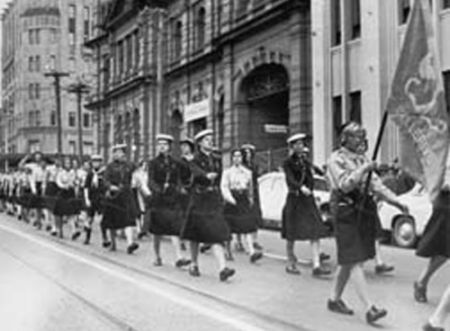 |
 |
|
Girl Guides
Following the publication of Scouting for Boys by Lord Baden-Powell in England in 1907, Tasmanian girls unofficially formed patrols in 1910. Lady Barron, wife of the governor, established Girl Guides officially in 1911. Other sections were established from 1920, including Brownies for younger girls, Rangers for older girls, and Lone Guides for isolated girls. In the 1990s Gumnut Guides commenced for girls under eight and Network Blue and Gold for young women. From 1996 all youth members have been called Guides with Units choosing their own Unit name. Trefoil Guilds, established in 1952, enable former Guides to continue to give service, and Guide Support Groups have raised money and provided other assistance since 1924. The purpose of Guiding is practical self-development in life skills and leadership qualities. Over 160,000 Tasmanian Guides have worked through the program originally designed by Lord Baden-Powell in 1910. This includes accepting the Promise and Law; working in Patrols (small groups) towards peak achievement awards (for example the Queen's Guide Award); giving service, both individually (from 1945 to 1953 five Tasmanians served voluntarily in war-ravaged Europe) and collectively (444 Peace Packs were given to refugees in 1995); community support (planting the national Field of Women for breast cancer awareness in 2003); outdoor activities of most types (hikes, abseiling, kayaking and campfires) and annual camping, from indoor holidays for younger Guides to outdoor camps and treks for older members, state camps for young leaders, Scout–Guide Regattas, interstate and international camps in Australia; overseas camps, conferences and events. Many thousands of Guides have been trained, selected, assisted to participate (including financially), and have gained from these enriching experiences. Other activities have included Interest Badges (typically, in 1976 Brownies earned 2672 Interest Badges); music and drama (included in campfires, church services, fund-raising concerts and special events ('Encore', from 1981 to 1994 and Hobart Gang Shows); community events (Anzac Parades, agricultural shows and pageants); rallies (Mullala), bonfires and special events (thousands welcomed the Baden-Powells in 1931 and many other visitors before and since); Jamboree of the Air and JOTInternet, plus a pen-friend program. These have enabled Guides to make friendships intrastate, interstate and internationally. Membership has ranged from 507 (1920) to a stable 4446 (1960–1982). A polio epidemic caused a drop in 1938 and a lack of leaders caused membership to drop to 1444 (1998); it is now stable, but the need for leaders is acute. None of the above could have occurred without trained, accredited, volunteer leadership, now undertaken through the Australian Adult Leaders Program. Since the Australian Trainers' program commenced in 1946, Tasmania has had ten outstanding Diploma'd Trainers, including Marjorie Andrews OAM, Gwen Hesketh OBE and Mary Hill OAM. Leading the leaders are the State Commissioner and a State Executive Committee of twelve members, plus fourteen specific purpose appointees, ten Division Leaders and nine sub-committees. Supporting these is the State Council, established in 1911 and currently consisting of 165 voting members. Guides Tasmania is a self-funded organisation, dependent mainly on member subscriptions and, since 1965, Guide Biscuit sales. The Association currently owns nine properties and other halls on local council land, all maintained by volunteers. Further reading: B Teniswood, Guiding in Tasmania, 1911–1973, Hobart, 1974. Linley Grant |
Copyright 2006, Centre for Tasmanian Historical Studies |
